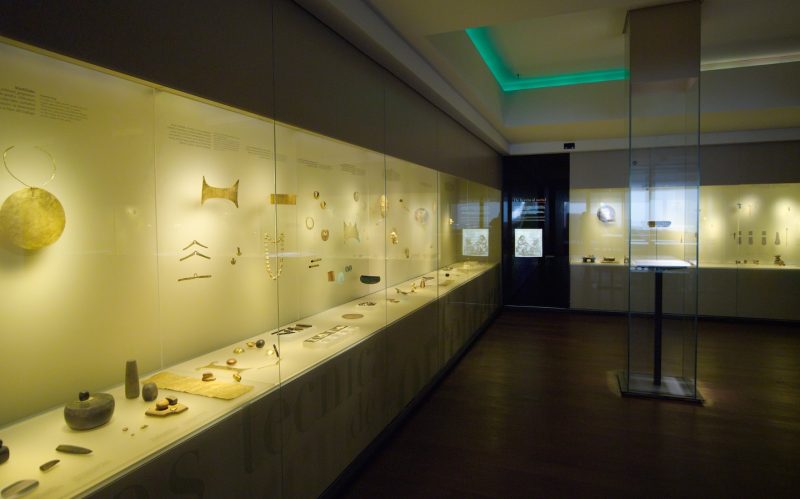Museum of Gold famed for its pre-Columbian artifacts
story by IAN STALKER photos by Nicolás Romero/ Museo del Oro
If the remarkably well crafted objects in the museum that Ana Maria Gonzalez works in seem as good as gold, that’s because they were made with that precious metal.
Gonzalez is the spokeswoman for Bogota’s Museum of Gold, which is home to 34,000 pre-Columbian gold artifacts, artifacts that Gonzalez is confident will dazzle visitors.
“The pieces on display in Museo del Oro belong to the pre-Hispanic goldsmith societies who inhabited the territory that is nowadays Colombia,” she says. “Their location, in the three mountain ranges, allowed the metal extraction of gold, copper, and platinum to make objects of great ritual significance.
“The goldsmiths were responsible for developing elaborate and complex techniques to work gold and transform it into objects of symbolic value in their society. They grew such a degree of mastery that nowadays, we are still surprised by the fineness and elegance of these objects. Its development began in South America around 1500 BC.”
Many tend to associate pre-Columbian South American goldworks with Inca creations from what are now Bolivia and Peru, but Gonzalez says those discovered in her homeland have different traits from those discovered in excavations outside Colombia’s frontiers.

“Goldsmith work in what is now Colombia has very particular and different characteristics from goldwork in other latitudes,” Gonzalez continues. “Undoubtedly, it was a material that worked exceptionally and carried a significant symbolic meaning for these societies. The current collection of Museo del Oro preserves 34,000 gold pieces total, making it the largest one of pre-Hispanic goldwork globally. Speaking of manufacturing skills, just looking at the museum’s exhibited objects is enough to be thrilled with pieces of great technique and aesthetic quality.”
Gold museum artifacts had great great symbolic value in the societies in which they were created, being buried with their owners to accompany them in the afterlife. “As a result of being kept in their tombs, they were, thankfully, not found by looters,” Gonzalez states.
Among Museum of Gold exhibits is the famous Muisca Raft, discovered in Pasca, Cundinamarca, in 1969, and an iconic piece in the museum’s collection. “It’s not just because of the beauty in its complex manufacture but because it is one of the few pieces that tell an unforgettable scene, the one narrated by the chronicler Juan Rodríguez Fraile about the (Indigenous) chief throwing himself into a lagoon covered in gold dust. This tale was the one to inspire the legend of El Dorado.”

The El Dorado tale evolved into one of a remote Lost City of Gold and long fascinated outsiders, among them Spanish conquistadors and Sir Walter Raleigh, who led expeditions in search of it.
The Muisca Raft — 7.7 inches long, 4 wide and 4 high and which has sculpted images of 11 people — is a Colombian icon, having been featured on stamps.
Gonzalez is uncertain whether there are more gold artifacts in her country awaiting discovery but if more are to be found she hopes it will be by archeologist’s “methodical work. Consequently, objects are recovered, along with the history that has yet to be found, avoiding treasure hunters, known for destroying contexts, thus, our history. “
“The Gold Museum is a must-see for those visitors who want an insightful travel experience and honour our ancestral and Indigenous ancestors,” says Carmen Caballero, president of Colombian tourist board ProColombia.
Caballero says the museum should be on the “bucket list of all international travellers.”
She adds that Bogota is a melting pot “where cultures from different territories” can be seen and the city can be reached from Toronto in six hours.

Among those who has visited the Museum of Gold is Lisa Lau of Toronto-based Okushu Tours.
“It was totally mind-blowing,” Lau says. “This museum is not only a showroom to the local Colombian people and foreign tourists to see a series of priceless world-class gold metal treasures, but also it is able to make us to understand the deep meaning before every piece when gold was used as the pre-Colombian civilization currency, the symbol of power and social status, used as the tools in daily life, what gold influenced the Indigenous Colombian people’s life.
“Some of the gold exhibits’ craftsmanship were incredible.
“I think most people do have a misconception that the ancient gold metalwork in South America must be in those biggest gold producers nowadays, such as Brazil, Perú, Argentina, and Chile,” Lau continues. “So visiting this gold museum in Colombia can give an opportunity for tourists to know more about gold history, facts and the close relationship among these South American countries.”
Meanwhile, Gonzalez suggests that those intrigued by pre-Columbian goldsmithing visit her museum, rather than doing as the likes of Raleigh did on journeys Gonzalez says were almost certainly futile.
“No, I don’t think there is a lost city of gold,” she adds. “The legend does refer to a territory with plenty of access to that metal. And that territory itself was Colombia.”
Bottom photo by Clark Manuel Rodríguez/Museo del oro

















